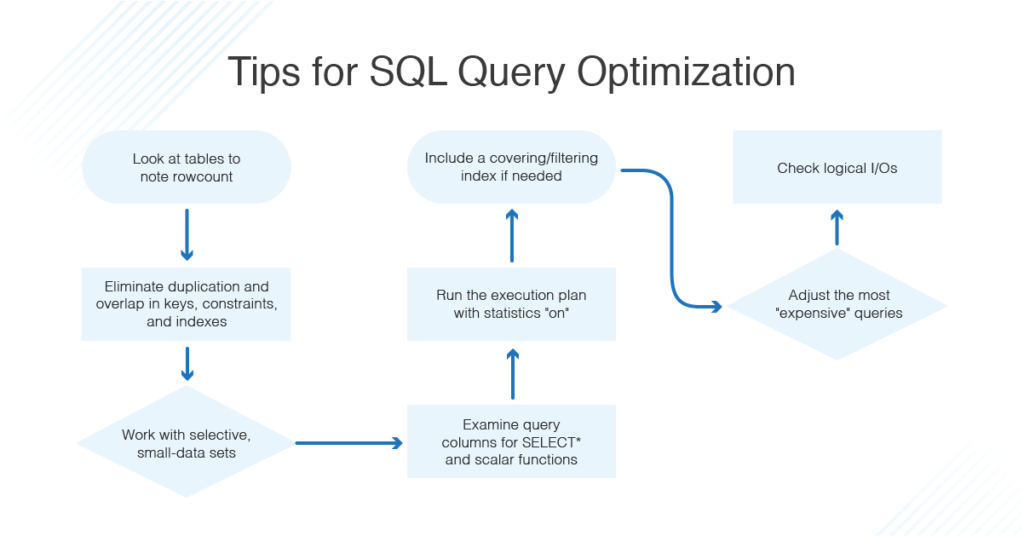
Query optimization is the overall process of choosing the most efficient means of executing a SQL statement. SQL is a nonprocedural language, so the optimizer is free to merge, reorganize, and process in any order.
- Introduction
- Query enhancement Advantages
- Fundamental Considerations for Logic Design
- Query optimisation techniques and Common mistakes
- Conclusion
Introduction

Data set is a fundamental programming part for any business. It contains hierarchical information and permits organizations to assemble elements to serve their clients. Around here at Halodoc, we widely utilize Relational Database Management Systems(RDBMS) too NoSQL information bases for our particular necessities.
We have arrangement dynamic and uninvolved observing frameworks for really taking a look at slow inquiries in the data set. We have empowered sluggish log and we have an exhibition knowledge screen for aloof checking. For dynamic observing, we have alarms on CPU, memory and application conduct. We have likewise made custom contents to trigger alarms when Query execution time arrives at a specific limit. These contents likewise end inquiries dependent on predefined standards.
This blog gives Query advancement strategies to planning great rationale and separating most extreme execution from the data set. Query rationale impacts data set server, application server, organization, IO and end-client experience.
- Limit creation issues: Every lethargic Query requires high CPU, memory, and IOPS. We have seen most creation information base issues are brought about by non-advanced Querys.
- Execution issues: Slow Query implies more slow reaction season of utilizations utilizing the inquiry, which brings about helpless end-client experience. It is vital to test rationale/Query with adequate information prior to running it underway.
- Save infra cost: Unoptimised Query requires more CPU, IOPS and memory. Extra burden can be put on a similar server assuming that Querys are advanced.
Query enhancement Advantages:-
- With bunching like Kubernetes it is moderately simple to scale application servers however proportional and burden balance the information base server it is standard to utilize a “source-copy” structure. This design empowers effective compose loads at the source and read-loads at imitations.
- Making and keeping up with copies and increasing it and down is costly and not so achievable as in application server.
- In outline, try not to insert complex business rationale in questions. Attempt to make light-weight SQL inquiries – staying away from complex joins and try not to since a long time ago run exchanges.
- The datatype of any segment is a significant piece of the table plan and essentially affects execution.
- For instance, utilizing Varchar(36) for putting away fixed-length information (UUID) will bring about a 20% inquiry executing punishment when contrasted with utilizing char(36) for fixed-length information. Comparatively utilizing scorch on factor segment can build size of information and size of the record.
- Planning table with an essential comprehension of datatype like varchar(1000) versus message can give execution benefits. A pointless enormous datatype builds information on the circle and diminishes the exhibition of the records .
- The list is an exceptionally basic piece of table plan. In Startups new elements go live habitually. It is vital to make lists at the hour of the making of the table or before new rationale goes into creation.
- It is additionally significant not to make such a large number of files on any table as it can dial back exchanges.
Fundamental Considerations for Logic Design:-
Comprehend the qualities and impediments of the data set frameworks
Query optimisation techniques and Common mistakes:-

1.Abstain from Using Different Character Encoding:
It requires verifiable change while making join on tables with various charset. The majority of time optimiser does on perform legitimate certain transformation of charset and not use record. We should utilize similar encoding across tables to use the better ordering component of the DB.
2. Comprehension of looking at sections datatypes:
In the above tables, phone_no is put away as VARCHAR in the primary table and mobile_no is BIGINT in the subsequent table. At the point when two sections with various datatypes get thought about in a question it probably won’t use the list.
3. Comprehension of section datatype contrasting and values:
In questions, one ought to try not to look at changed datatype section and worth. At the point when a question looks at changed datatypes, it utilizes certain datatype transformation. For instance in the inquiry beneath, mobile_no is a BIGINT datatype however question contrasting as CHAR esteem.
4. Try not to utilize Function-based statement in where condition:
At the point when a question involves a capacity in the where or join condition on the segment, it would not use the record.
5. Try not to utilize DISTINCT and GROUP BY simultaneously:
The inquiry beneath has execution overhead when it utilizes Distinct and Group By together, GROUP BY itself makes lines particular. Involving GROUP BY as in the underneath question likewise has one disadvantage, it will give irregular qualities for those columns(b.customer_name) that don’t have a gathering capacity.
6. Try not to utilize UNION and DISTINCT simultaneously:
Association itself makes unmistakable records, so we want not utilize DISTINCT with UNION.
7. Try not to choose pointless segments:
Choosing pointless segments would be a misuse of memory, CPU cycle and organization. Each question ought to choose just the necessary segments for better inquiry execution.
8. Abstain from utilizing Long-running exchange:
At the point when a DML inquiry is executed on a huge information range, during the execution time the exchange might lock pushes or may lock the full table. During this lock time the information base denies simultaneous exchanges and other DML questions would be in a stand by express, this like little personal time on the table access. Breaking long running exchanges into more modest exchange can be more streamlined while making an UPDATE or Delete question.
9.Avoid subquery where conceivable:
MySQL and numerous information bases perform more slow when there is a subquery in SQL explanation question. Subquery makes temp tables to store information and at times it makes temp tables on the circle in this manner easing back the inquiry execution. We ought to keep away from such questions however much as could be expected as it isn’t adaptable.
10.Avoid involving Subquery IN and NOT IN:
MySQL and numerous information bases perform more slow when there is a subquery in SQL proclamation question. Subquery makes temp tables to store information and now and then it makes temp tables on the circle consequently easing back the question execution.
Conclusion:-
We take care of a portion of the significant question improvement strategies that we have learn throughout the long term and is known to create great outcomes. There are different other conceivable enhancement choices for inquiries like utilization of where rather than having, utilization of pagination and so on,
On the off chance that you perseveringly follow the inquiry advancement strategies definite above, you could profit from further developed question execution, lesser creation issues and save cost by limiting assets.





